ECU Citroen DS4 RHD 2011.5 1.G User Guide
[x] Cancel search | Manufacturer: CITROEN, Model Year: 2011.5, Model line: DS4 RHD, Model: Citroen DS4 RHD 2011.5 1.GPages: 396, PDF Size: 12.14 MB
Page 168 of 396

Your vehicle has been approved in accordance
with the new
ISOFIX regulation.The seats, represented below, are fitted withregulation ISOFIX mountings:
"ISOFIX" mountings
There are three rings for each seat:
- two rings A, located between the vehicle seat back and cushion, indicated by a label,
- a rin
g Bbehind the seat for fixing the upper strap, referred to as the To p Te t h e r.
r
This ISOFIX mounting system provides fast,
reliable and safe fitting of the child seat in your
vehicle.
The incorrect installation of a child seat in a vehicle compromises the child'sprotection in the event of an accident.
For information re
garding the ISOFIX childseats which can be installed in your vehicle,
refer to the table showing the locations for
installing ISOFIX child seats.
When fitting an ISOFIX child seat tothe left hand rear seat, before fitting the seat, first move the centre rear seatbelt towards the middle of the vehicle, so as to avoid the seat inter fering withthe operation of the seat belt.
The ISOFIX child seatsare fitted with two latches which are secured on the two rings A. Some seats also have an upper strap
, known
as the Top Tether, which is attached to ring B.
To a t t a c h t h i s s t r ap, raise the vehicle seat's head restraint then pass the hook between its
rods. Then fix the hook on ring Band tighten
the upper strap.
Page 169 of 396

167
Child safety
ISOFIX child seat recommended by CITROËN and approved for
your vehicle
This child seat can also be used on seats which are not fitted with ISOFIX mountings. In this case, it must be attached to the vehicle seat using the three point seat belt.Follow the instructions for fitting the child seat given in the seat manufacturer's installation guide.
"
RÖMERDuo Plus ISOFIX"(size category B1)
Group 1: from 9 to 18 kg
Installed only in the forwards-facing position.Fitted with an upper strap to be secured on the upper ring B, referred to as the TOP TETHER.
Three seat body angles: sitting, reclining, lying.
�) Adjust the front seat of the vehicle so that the child's feet do not touch the back of the seat.
Page 170 of 396
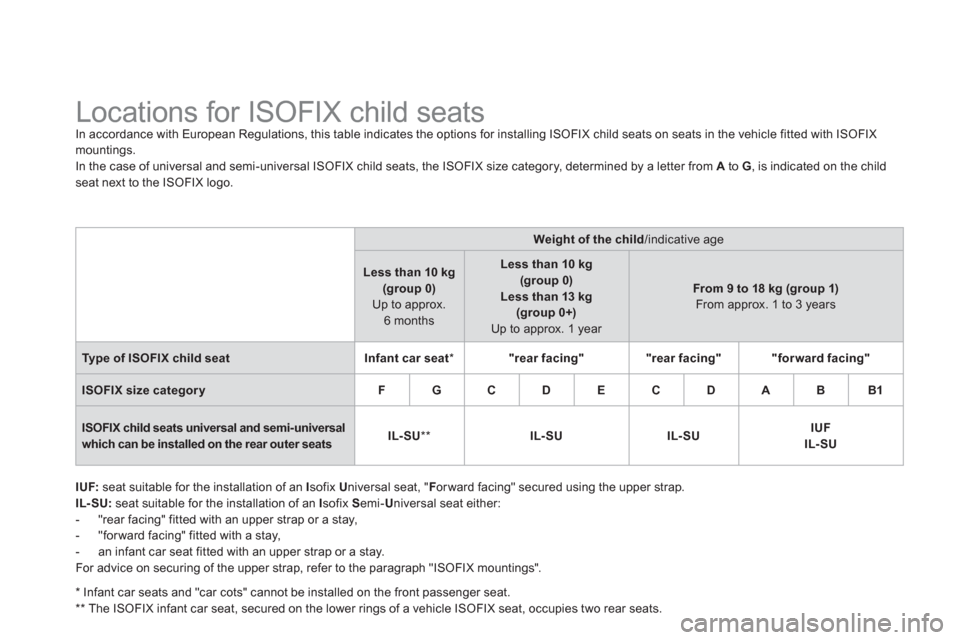
Locations for ISOFIX child seats In accordance with European Regulations, this table indicates the options for installing ISOFIX child seats on seats in the vehicle fitted with ISOFIXmountings.
In the case o
f universal and semi-universal ISOFIX child seats, the ISOFIX size category, determined by a letter from Ato G , is indicated on the childseat next to the ISOFIX logo.
IUF:seat suitable for the installation of an I sofix U
niversal seat, "F
orward facing" secured using the upper strap.IL- SU:
seat suitable for the installation of an I sofix S emi-U
niversal seat either:
- "rear facing" fitted with an upper strap or a stay,
- "forward facing" fitted with a stay,
- an infant car seat fitted with an upper strap or a stay.
For advice on securing of the upper strap, refer to the paragraph "ISOFIX mountings".
* Infant car seats and "car cots" cannot be installed on the front passenger seat.
** The ISOFIX infant car seat, secured on the lower rings of a vehicle ISOFIX seat, occupies two rear seats.
Weight of the child
/indicative age
Less than 10 kg(group 0)Up to approx. 6 months
Less than 10 kg(group 0)
Less than 13 kg(group 0+)Up to approx. 1 year
From 9 to 18 kg (group 1)From approx. 1 to 3 years
Type of ISOFIX child seatInfant car seat
*"rear facing""rear facing""for ward facing"
ISOFIX size categoryFGCDECDABB1
ISOFIX child seats universal and semi-universalwhich can be installed on the rear outer seatsIL-SU**IL-SUIL-SUIUFIL- SU
Page 184 of 396

The driver must ensure that passengers usethe seat belts correctly and that they are allrestrained securely before setting off.
Wherever you are seated in the vehicle, always fasten your seat belt, even for short journeys. Do not interchange the seat belt buckles as they will not fulfil their role fully.
The seat belts are fitted with an inertia reel permitting automatic adjustment of the lengthof the strap to your size. The seat belt isstowed automatically when not in use.
Before and after use, ensure that the seatbelt is reeled in correctly.
The lower part of the strap must be positioned as low as possible on the pelvis.
The upper par t must be positioned in the hollow of the shoulder.
The inertia reels are fitted with an automatic locking device which comes into operation inthe event of a collision, emergency braking or if the vehicle rolls over. You can release the device by pulling firmly on the strap and releasing it so that it reels in slightly.
In order to be effective, a seat belt must:
- be tightened as close to the body as possible,
- be pulled in front of you with a smooth movement, checking that it does nottwist,
- be used to restrain only one person,
- not bear any trace of cuts or fraying,
- not be converted or modified to avoidaffecting its per formance.
In accordance with current safety regulations, for all repairs on your vehicle, go to aqualified workshop with the skills and equipment needed, which a CITROËN dealer is able to provide. Have your seat belts checked regularly by a CITROËN dealer or a qualified workshop, particularly if the straps show signs of damage.
Clean the seat belt straps with soapy water or a textile cleaning product, sold by CITROËN dealers.
After folding or moving a seat or rear benchseat, ensure that the seat belt is positioned and reeled in correctly.
Recommendations for children
Use a suitable child seat if the passenger is less than 12 years old or shor ter than one and a half metres.
Never use the same seat belt to secure more than one person.
Never allow a child to travel on your lap.
In the event of an impact
Depending on the nature andseriousness of the impact , the pretensioning device may be deployed before and independently of the airbags.Deployment of the pretensioners is accompanied by a slight discharge of harmless smoke and a noise, due to theactivation of the pyrotechnic cartridge incorporated in the system.
In all cases, the airbag warning lampcomes on.
Following an impact, have the seat beltssystem checked, and if necessary replaced, by a CITROËN dealer or a qualified workshop.
Page 190 of 396
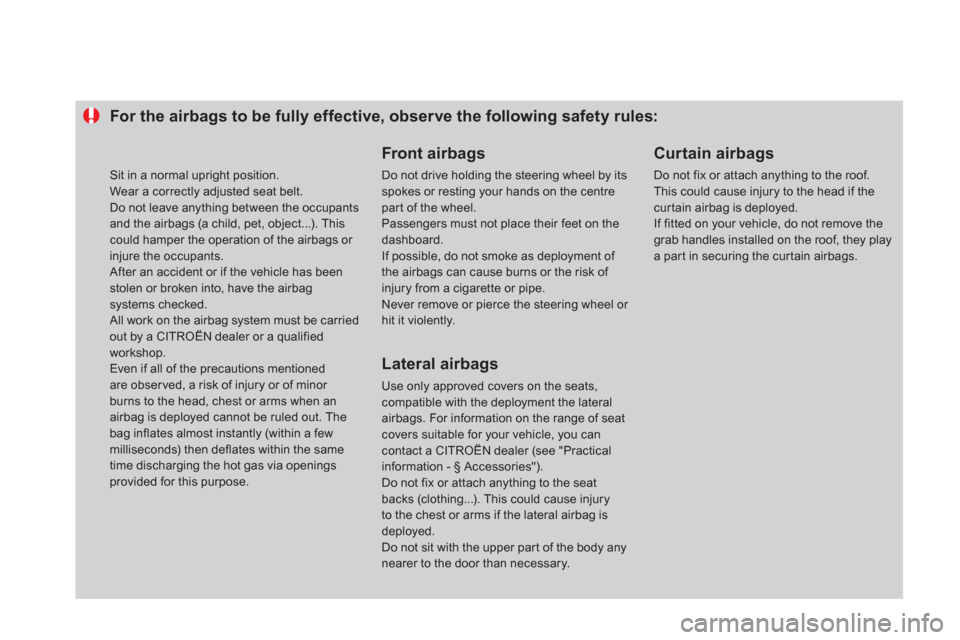
For the airbags to be fully effective, observe the following safety rules:
Front airbags
Do not drive holding the steering wheel by its spokes or resting your hands on the centre par t of the wheel.
Passengers must not place their feet on thedashboard.
If possible, do not smoke as deployment of the airbags can cause burns or the risk of injury from a cigarette or pipe.
Never remove or pierce the steering wheel or hit it violently.
Lateral airbags
Use only approved covers on the seats,compatible with the deployment the lateral airbags. For information on the range of seat covers suitable for your vehicle, you cancontact a CITROËN dealer (see "Practicalinformation - § Accessories").
Do not fix or attach anything to the seat backs (clothing...). This could cause injury to the chest or arms if the lateral airbag isdeployed.
Do not sit with the upper par t of the body any nearer to the door than necessary.
Curtain airbags
Do not fix or attach anything to the roof. This could cause injury to the head if thecurtain airbag is deployed.
If fitted on your vehicle, do not remove the grab handles installed on the roof, they play a par t in securing the cur tain airbags.
Sit in a normal upright position.
Wear a correctly adjusted seat belt.
Do not leave anything between the occupantsand the airbags (a child, pet, object...). This could hamper the operation of the airbags or injure the occupants. After an accident or if the vehicle has beenstolen or broken into, have the airbagsystems checked. All work on the airbag system must be carriedout by a CITROËN dealer or a qualified workshop.
Even if all of the precautions mentioned are obser ved, a risk of injury or of minor burns to the head, chest or arms when an airbag is deployed cannot be ruled out. The
bag inflates almost instantly (within a few milliseconds) then deflates within the sametime discharging the hot gas via openings provided for this purpose.
Page 233 of 396

231Checks
Bonnet
Opening
�)Open the front left door.�)Pull the interior bonnet release lever A ,
located at the bottom of the door aperture.
�) Push the exterior safety catch Bto the leftand raise the bonnet.
�)
Unclip the stay C
from its housing on the back of the bonnet. �)
Fix the stay in the notch to hold the bonnet open.
The location of the interior bonnet release lever prevents opening of the bonnet while the front left door isclosed.
Do not open the bonnet in high winds. When the engine is hot, handle theexterior safety catch and the bonnet
stay with care (risk of burns).
Before doing anything under the bonnet, switch off the Stop & Startsystem to avoid any risk of injury
resulting from an automatic change toSTA R T m o d e .
Closing
�)
Take the stay out of the support notch. �)
Clip the stay in its housing on the back of
the bonnet.�) Lower the bonnet and release it at the endof its travel. �)
Pull on the bonnet to check that it is secured correctly.
Page 239 of 396
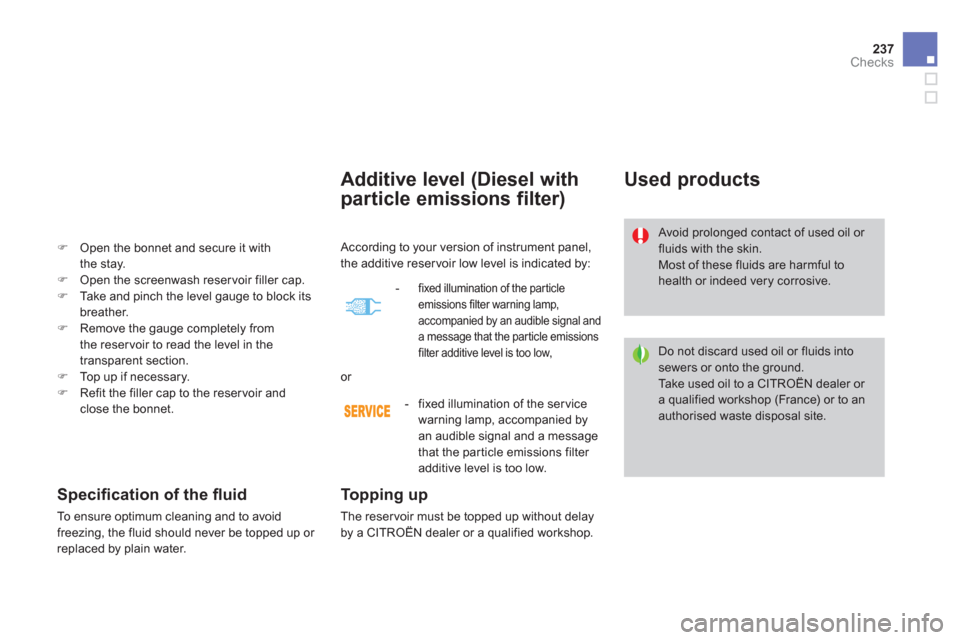
237
Checks
Additive level (Diesel with
particle emissions filter
)
To p p i ng up
The reser voir must be topped up without delay
by a CITROËN dealer or a qualified workshop.
Used products
Avoid prolonged contact of used oil or fluids with the skin.
Most of these fluids are harmful tohealth or indeed very corrosive.
Do not discard used oil or fluids into sewers or onto the ground.
Take used oil to a CITROËN dealer or a qualified workshop (France) or to anauthorised waste disposal site.
�)Open the bonnet and secure it withthe stay. �)Open the screenwash reservoir filler cap. �)Take and pinch the level gauge to block its breather. �)Remove the gauge completely from
the reservoir to read the level in the
transparent section. �)Top up if necessary. �)Refit the filler cap to the reser voir and close the bonnet.
Specifi cation of the fl uid
To ensure optimum cleaning and to avoid
freezing, the fluid should never be topped up or
replaced by plain water. Accordin
g to your version of instrument panel,
the additive reser voir low level is indicated by:
-fixed illumination of the particle emissions filter warning lamp, accompanied by an audible signal anda message that the particle emissionsfilter additive level is too low,
or
- fix
ed illumination of the servicewarning lamp, accompanied by
an au
dible signal and a message
that the par ticle emissions filter additive level is too low.
Page 251 of 396
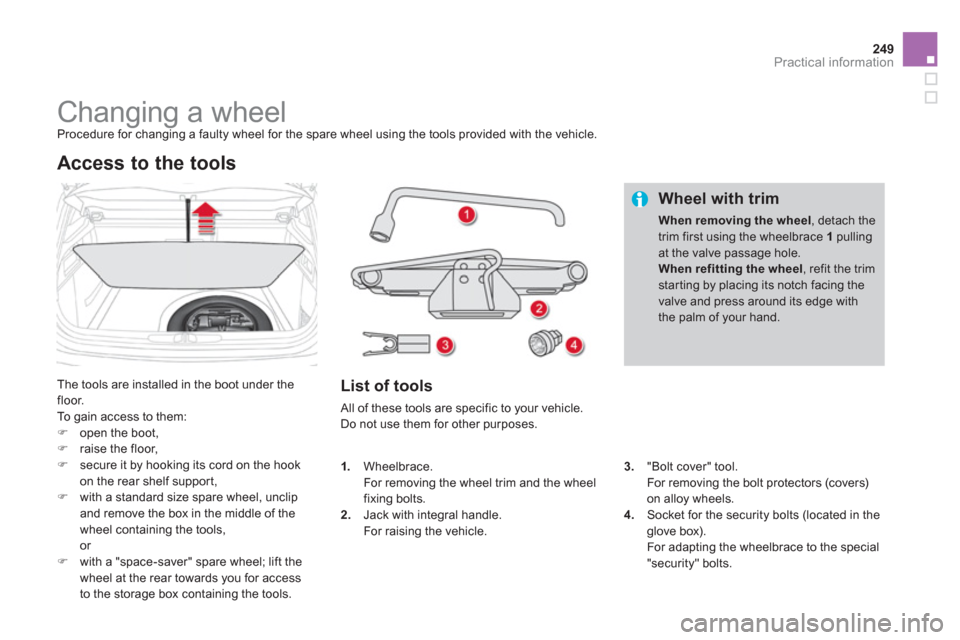
249Practical information
Changing a wheel
Procedure for changing a faulty wheel for the spare wheel using the tools provided with the vehicle.
The tools are installed in the boot under the floor.
To gain access to them: �)open the boot, �)raise the floor,�)secure it by hooking its cord on the hook
on the rear shelf suppor t,
�)with a standard size spare wheel, unclip and remove the box in the middle of the
wheel containing the tools,
or �)with a "space-saver" spare wheel; lift the
wheel at the rear towards you for access
to the storage box containing the tools.
Access to the tools
List of tools
All of these tools are specific to your vehicle. Do not use them for other purposes.
Wheel with trim
When removing the wheel, detach thetrim first using the wheelbrace 1pulling at the valve passage hole.When refitting the wheel
, refit the trim starting by placing its notch facing the valve and press around its edge withthe palm of your hand.
3."Bolt cover" tool.
For removing the bolt protectors (covers)on alloy wheels.4.Socket for the security bolts (located in theglove box).
For adapting the wheelbrace to the special"security" bolts. 1
.Wheelbrace.
For removing the wheel trim and the wheel
fixing bolts.
2. Jack with integral handle.For raising the vehicle.
Page 254 of 396
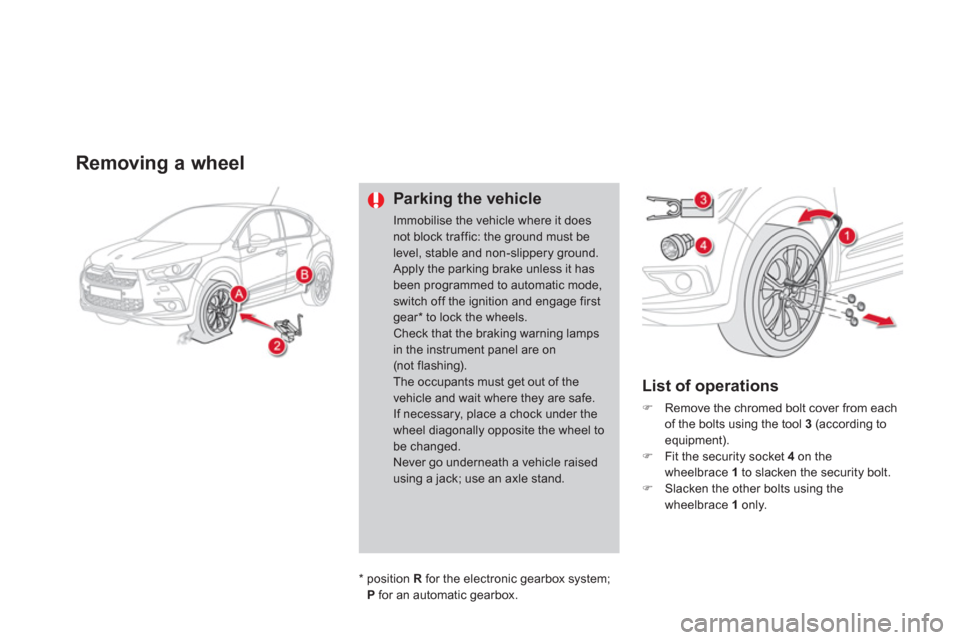
Removing a wheel
Parking the vehicle
Immobilise the vehicle where it does not block traffic: the ground must be level, stable and non-slippery ground. Apply the parking brake unless it hasbeen programmed to automatic mode, switch off the ignition and engage first gear * to lock the wheels.Check that the braking warning lamps in the instrument panel are on(not flashing). The occupants must get out of thevehicle and wait where they are safe.If necessary, place a chock under the wheel diagonally opposite the wheel tobe changed. Never go underneath a vehicle raisedusing a jack; use an axle stand.
List of operations
�)
Remove the chromed bolt cover from each
of the bolts using the tool 3 (according toequipment).�)
Fit the security socket 4
on thewheelbrace 1to slacken the security bolt. �)
Slacken the other bolts using the
wheelbrace 1only.
*
position
Rfor the electronic gearbox system;
P
for an automatic gearbox.
Page 256 of 396
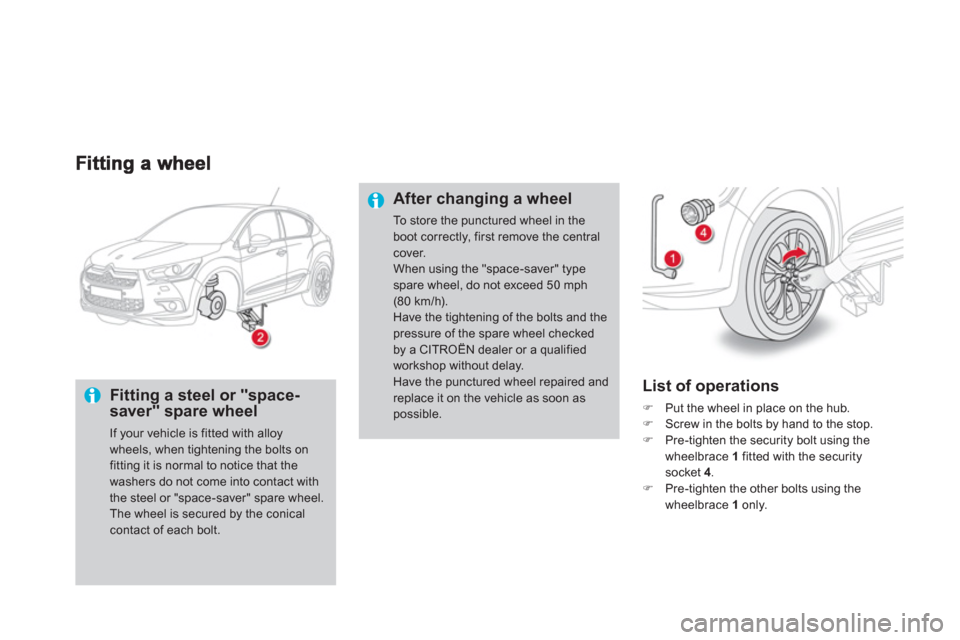
Fitting a steel or "space-saver" spare wheel
If your vehicle is fitted with alloy wheels, when tightening the bolts onfitting it is normal to notice that thewashers do not come into contact with the steel or "space-saver" spare wheel.The wheel is secured by the conical contact of each bolt.
List of operations
�)Put the wheel in place on the hub. �)Screw in the bolts by hand to the stop.
�)Pre-tighten the security bolt using the
wheelbrace 1fitted with the security socket 4.�)Pre-tighten the other bolts using the
wheelbrace 1only.
After changing a wheel
To store the punctured wheel in the boot correctly, first remove the centralcover. When using the "space-saver" typespare wheel, do not exceed 50 mph(80 km/h). Have the tightening of the bolts and thepressure of the spare wheel checked by a CITROËN dealer or a qualified workshop without delay. Have the punctured wheel repaired andreplace it on the vehicle as soon aspossible.